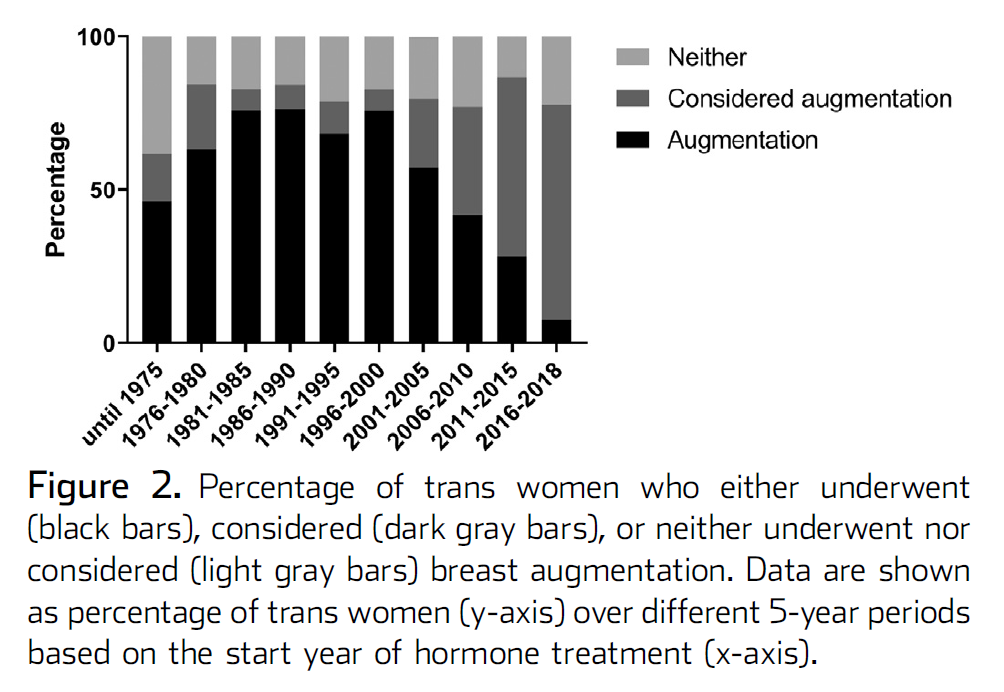

A recent study from the VU University Medical Center gender clinic in the Netherlands presents a remarkably extensive analysis of breast augmentation among trans women, spanning 773 women who began receiving HRT at the clinic between 1972 and 2018. de Blok et al. (2020) examined how rates of augmentation surgery have changed over time, how soon trans women tend to have augmentation after starting HRT, and how many trans women want or don’t want this surgery.
The respondents were a median age of 50 years old and had been on HRT for a median of 7 years; previous studies have suggested that breast development in trans women is largely complete after 2-3 years of HRT (Phillips et al., 2014). Overall, 40% of these women had received breast augmentation surgery and another 41% stated that they had considered it or desired it but had not received it, while 19% had not received or considered receiving breast augmentation. This is consistent with the findings of the 2015 U.S. Transgender Survey (James et al., 2016) in which 19% of transfeminine respondents did not want breast augmentation and 40% did want it, although only 11% had actually received it.
de Blok et al. further observe a substantial difference in rates of breast augmentation over time, with 70% of those who began transitioning from 1980-2000 receiving this surgery, but only 20% of those who started their transition from 2010-2015. Trans women overall received surgery a median of 2 years after starting HRT, and those who most recently began transition frequently indicated that they were waiting for further breast growth before undergoing augmentation; the authors also note that breast augmentation was previously a more routine aspect of transition at this clinic:
In earlier years, breast augmentation was part of the transition and was often performed at the same time as vaginoplasty. This may be an explanation of the difference in percentage of trans women with breast implants between the different cohorts. On the other hand, most of the trans women who have not undergone breast augmentation were still awaiting further breast development with hormone treatment.
However, the total proportion of women who have either received or are potentially interested in receiving augmentation appears to have remained generally consistent over time:


There’s previously been speculation as to whether starting transition in adolescence with puberty blockers followed by cross-sex hormone therapy would produce greater breast development than is seen when starting HRT after natal puberty has already finished. Contrary to this, the authors found that among those women who started HRT at age 18 or younger, 37% received breast implants, a rate similar to the 41% of those who started HRT between ages 19-30 and 40% of those who started at 31 or older.
Trans women in the study who had undergone breast augmentation also indicated their reasons for having surgery, with 85% stating that they sought augmentation “because of insufficient breast development with hormone treatment”. While 80% of these women stated that they were satisfied with the results of surgery, 33% reported having health problems or other complaints due to their breast implants. Similarly, Xu et al. (2019) reported complication rates of 20.5% in trans women receiving their first augmentation and 44.4% in those receiving revision surgery, higher than the complication rates of 1.4-14.5% in cis women undergoing breast augmentation.
Interestingly, although many of us may find this difficult to fathom, some trans women in the present study reported ongoing breast development after augmentation to the point that their breasts became even larger than they had wanted:
An important observation was that 17 trans women wrote that their breast volume increased years after the start of hormone treatment, even sometimes years after breast augmentation. In some cases, this led to a breast size larger than desirable.
Once again, the extent of breast development on HRT alone can be highly variable among trans women, with final sizes ranging from small to above-average. However, this study reaffirms that a likely majority of trans women do wish to receive breast augmentation, that this is usually motivated by insufficient breast growth from HRT, and that this surgery can be necessary for some trans women regardless of whether they began transitioning in adolescence or adulthood. Given the opportunity to receive this surgery, many trans women will seek to obtain it as an important part of their transition. ■

View Comments (0)